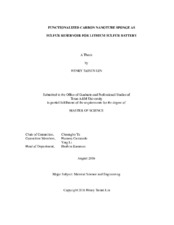| dc.contributor.advisor | Yu, Choongho | |
| dc.creator | Lin, Henry Taisun | |
| dc.date.accessioned | 2019-01-18T19:57:39Z | |
| dc.date.available | 2019-01-18T19:57:39Z | |
| dc.date.created | 2016-08 | |
| dc.date.issued | 2016-07-22 | |
| dc.date.submitted | August 2016 | |
| dc.identifier.uri | https://hdl.handle.net/1969.1/174254 | |
| dc.description.abstract | Lithium sulfur batteries offer many advantages such as high specific capacity, environmental friendliness and low cost. However, several problems limit their commercialization, like low sulfur utilization because of the insulating nature of sulfur, and capacity degradation caused by dissolution of the intermediate product, polysulfide. Herein, we proposed that unzipping the carbon nanotube electrode to increase its surface area can enhance sulfur utilization due to the larger contact area. Furthermore, graphene oxide was chosen as a polysulfide immobilizer due to the electrostatic interaction between graphene oxide and polysulfide. Our results show much better battery cycle performance after the treatments just mentioned before, which are reliable supports for the hypothesis. | en |
| dc.format.mimetype | application/pdf | |
| dc.language.iso | en | |
| dc.subject | Li-S battery | en |
| dc.subject | functionalized CNT | en |
| dc.subject | CNT sponge | en |
| dc.title | Functionalized Carbon Nanotube Sponge as Sulfur Reservoir for Lithium Sulfur Battery | en |
| dc.type | Thesis | en |
| thesis.degree.department | Materials Science and Engineering | en |
| thesis.degree.discipline | Materials Science and Engineering | en |
| thesis.degree.grantor | Texas A & M University | en |
| thesis.degree.name | Master of Science | en |
| thesis.degree.level | Masters | en |
| dc.contributor.committeeMember | Castaneda, Homero | |
| dc.contributor.committeeMember | Li, Ying | |
| dc.type.material | text | en |
| dc.date.updated | 2019-01-18T19:57:39Z | |
| local.etdauthor.orcid | 0000-0002-3174-1384 | |


